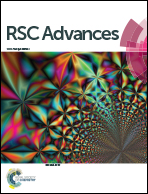Fabrication of TiO2–graphene composite for the enhanced performance of lithium batteries
Abstract
The controllable synthesis of TiO2 nanostructures with a conformal and ultrathin graphitic carbon coating is critically desirable for new anode material development for Li-ion batteries. In the present study, TiO2 nanoparticles (NPs) synthesized by a facile sol–gel method were encapsulated in graphene nanosheets (GNS) to improve the electrochemical performance. The encapsulation was facilitated by electrostatic interaction between the positively charged silane-decorated TiO2 surface and the negatively charged graphene oxide. Following encapsulation, the graphene oxide was reduced to create a graphene-encapsulated TiO2 nanocomposite. The uniform and individual wrapping of TiO2 nanoparticles by graphene was verified by transmission electron microscopy (TEM), and the measured graphene wrapping thickness agreed well with the calculated thickness based on the TGA data and size distribution of the TiO2 NPs. The TiO2/graphene anode resulted in an initial capacity of 292.3 mA h g−1, a coulombic efficiency of 100%, and a high specific capacity of 247.4 mA h g−1 after 100 cycles at a current density of 330 mA h g−1 (1C). It also demonstrated an outstanding high rate performance with a retained capacity of 158 mA h g−1 at a rate of 20C.



 Please wait while we load your content...
Please wait while we load your content...